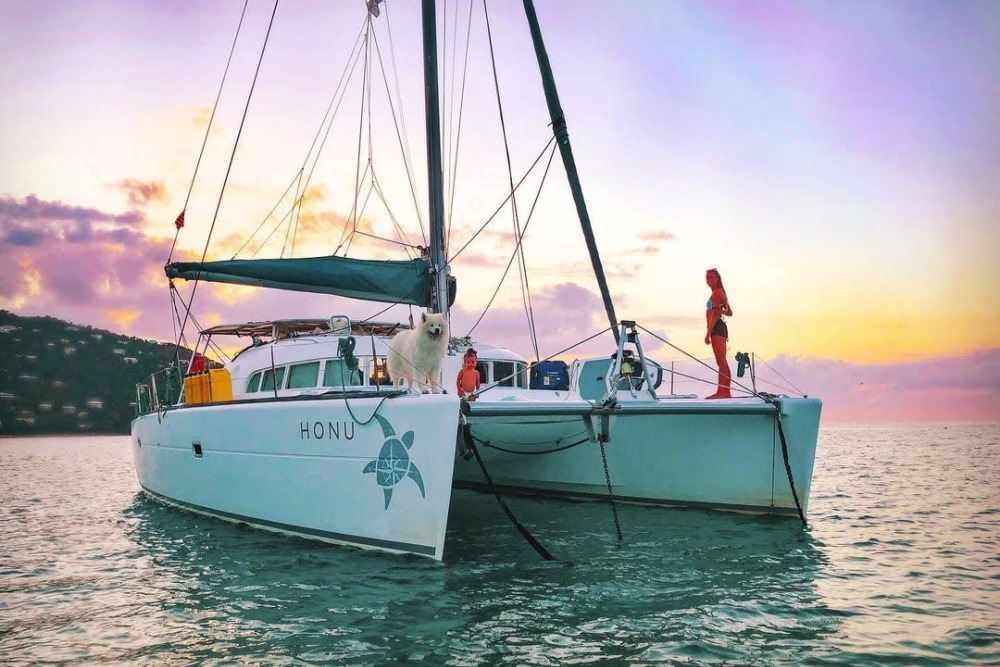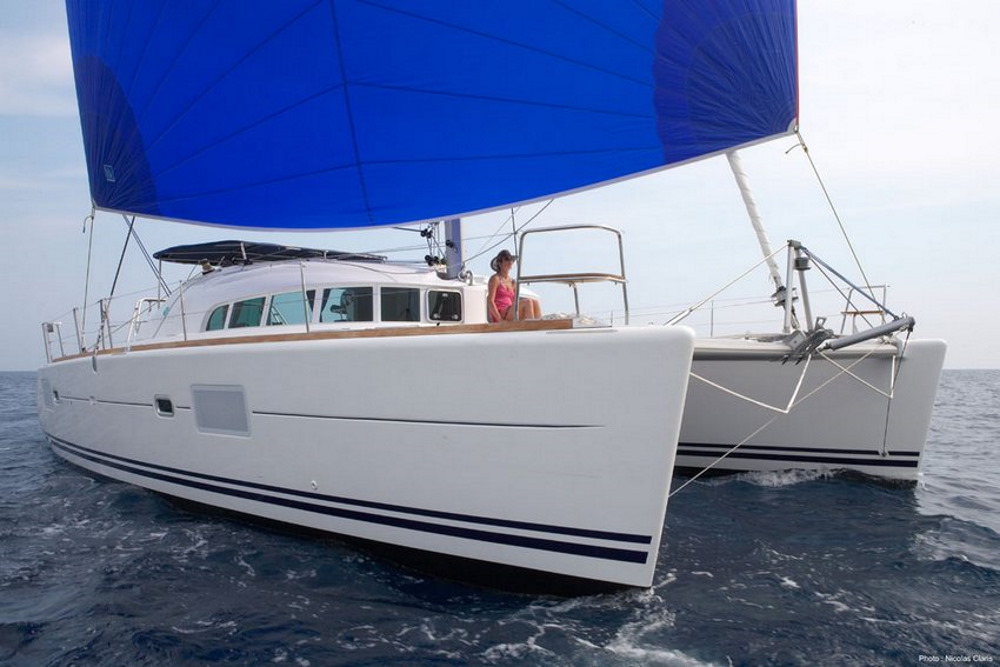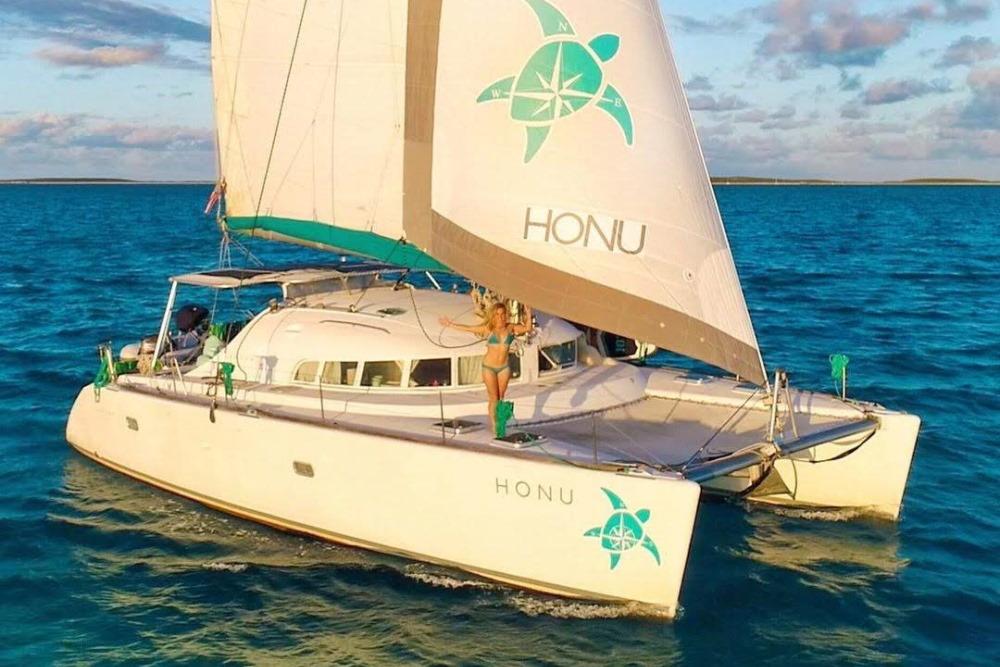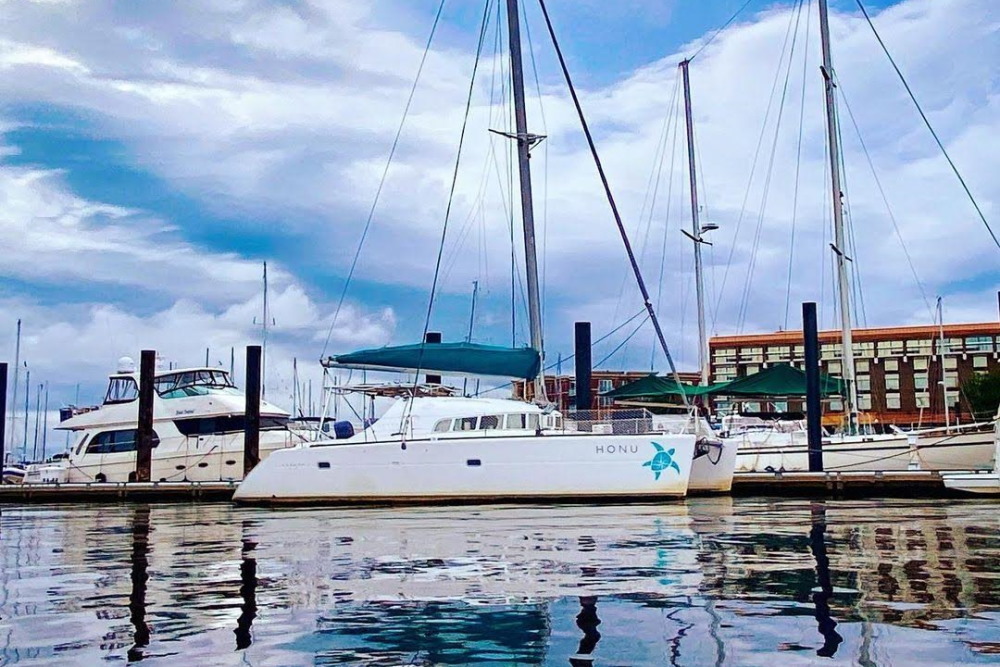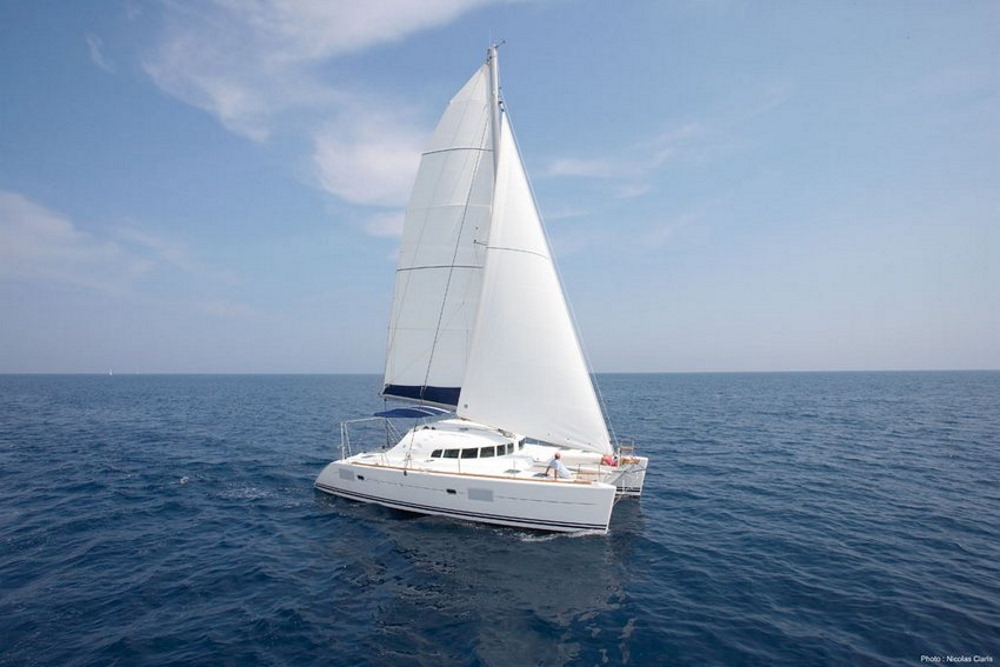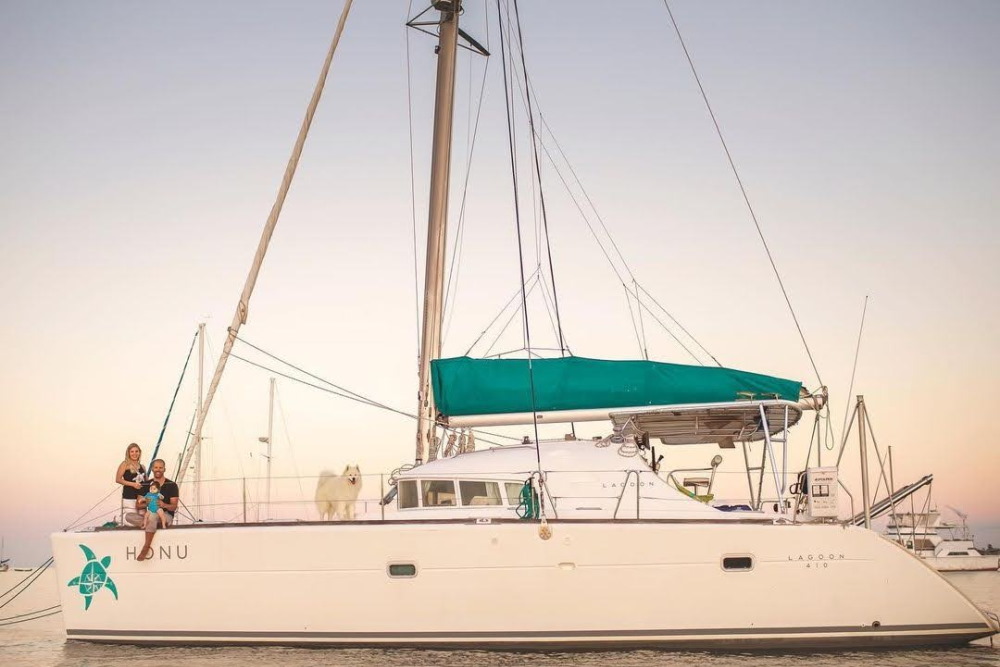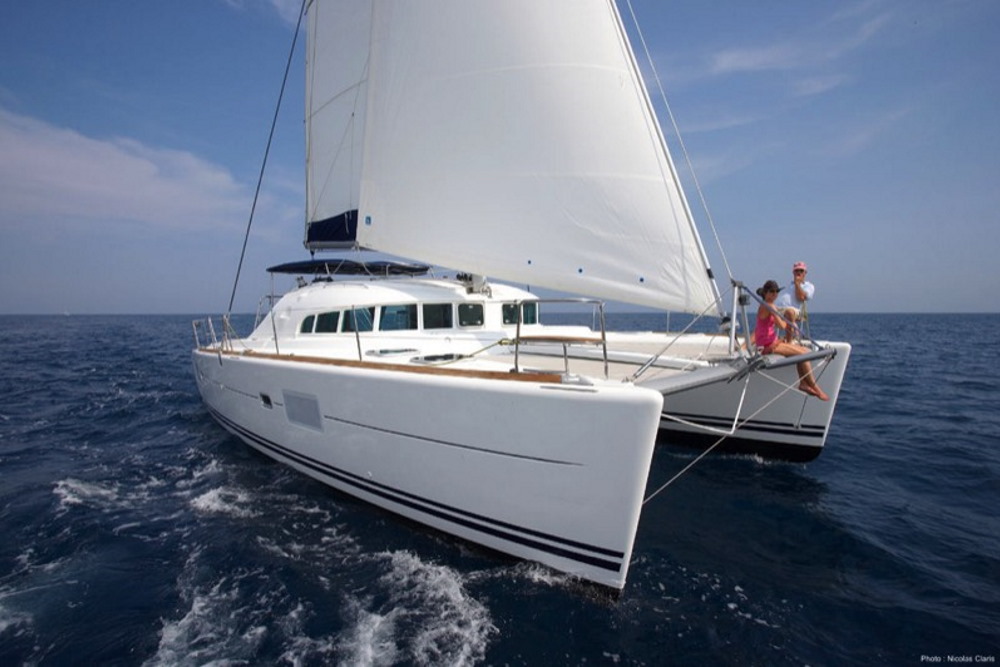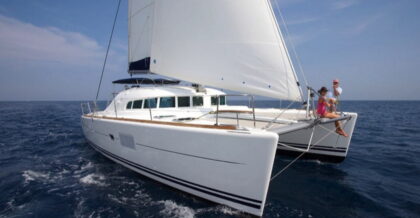The Lagoon 410 was one of the French manufacturer’s most successful 2nd Generation models, along with the L380. This boat remains very popular on the second hand market.
The 410 replaced the 1st generation 42 in 1997 and was the first in the new series of designs after Lagoon was bought by Beneteau. This is where they started to veer towards comfort over performance, but these early models still had punchy Sail Area to Displacement ratios (SA/D) and were sturdily built. The world has moved on considerably of course, with yachts like the Bali Catspace competing in this market segment, but the 410 has stood the test of time. It remains an excellent 2nd hand option in this size range.
Compared to the sportier Lagoon 42, VPLP designed this boat with more space inside and put the saloon on a level with the cockpit (pretty innovative at the time). The keels were made fuller, with more volume on the ends of the hulls to reduce pitching. It’s no exaggeration to say that this boat has inspired many later designs though. Read our Leopard 42 review for an example.
Photo credit: Nicolas Claris, Insta @jessicaandryanadventures, @sailingfamily_troppo
The 410 was built wider to increase lateral stability, safety and volume. They reduced the size of the main and increased the size of the jib with the same overall sail area. This is no performance cat (read our O-Yachts Class 4 review if that is what you are after), but it does what it set out to do very well.
The 410 is now a classic catamaran.
Pros
- If you keep her light, she performs very well for a cruising catamaran.
- The Lagoon is a very easy boat to access and work on.
- More living space than a 380, more storage, more comfortable galley.
- Probably 10-20% faster than a 380 under sail and power and more comfortable in a seaway
- Will do 50-60% of windspeed on a reach and point to 45 degrees, although you are better dropping off 10.
- Spacious heads for this size boat
- Good visibility from the helm position
- The interior furnishing doesn’t wear too well (eg delaminating wood interiors). That’s an easy fix though
Cons
- The 410s are solid glass below the waterline with a balsa core above the waterline. If it stays dry this is no problem, but if moisture has crept in, it can be expensive to repair. Check all deck gear is firmly attached and sealed (pad eyes, bolts, blocks, stanchions, posts, etc).
- Engines are under the bunks. You could also argue this as a “Pro” as it keeps the weight centred. Access is through the rear cabins though.
- Owners have reported slapping on the flat surface under the aft berths (square step). In big waves, this can get noisy
410 and 410 S2
As with many of the Lagoons of this generation, the 410 had a design upgrade halfway through its life and became the Lagoon 410 S2
The main changes from the 410 to 410 S2 are:
- Bigger windows in cabins letting more light in and improving the view from the berths.
- They rearranged the galley.
- The halyards were moved from the mast to the cockpit
- Electric winch installed for main halyard and mainsheet
- The anchor placement to the bow.
The Lagoon 410 is easy to move around in, with decent headroom, and wide passageways. The helm position design was such a success, that they haven’t really changed it since (on this size of Lagoon).
They developed the 410 as a roomier boat than its predecessor (the 42). a big market for this boat was the charter market, of course, but it was also a popular owner’s boat with the owner’s hull configuration: a large starboard shower-room and head and a study
in place of the fore starboard cabin on the charter versions.
The charter versions can have up to four double cabins, each with
a head.
The Raised Helm
The Raised Helm on the 410 was an undoubted design success and has been continued into the newer Lagoon designs and copied by much of the competition.
Sailing
The 410 is pleasant to sail, with good handling in a seaway and moderate pitching. On port tack, close hauled on a windy day, you will need your wet weather gear, but on most points of sail you are well protected. She is an easy boat to sail short handed, despite the fact that she doesn’t have a self tacking jib, and well organised, particularly on the 410 s2.
You can expect 7 knots or so close-hauled with 16 knots TWS, and these speeds will head just over 10 knots as you bear away and the wind freshens. 100 degree tacks are achievable in decent conditions.
Summary
If you are looking for a 40 foot second hand cruising catamaran, the 410 should be on your list. She matches the 380 as a classic catamaran design. They built less of the 410s though, so it will be harder to find a decent one. The extra length and stability of the 410 over the 380 is worth considering if you have the budget or you are considering longer passages.
Lagoon 410 S2 Brochure
View the 2005 Lagoon 410 S2 Brochure
FAQs
How much is a Lagoon 410 on the second hand market? What is the price for one of these catamarans?
These boats are popular. You can expect to pay between US$ 180,000 and $250,000 depending on the age and condition.
How many 410 hulls did Lagoon build?
The 410 was in production from 1997 to 2006. A long run! They build around 280 units in that time. Not as many as the 380, but still, a substantial number.
View this post on Instagram
Technical Specification
| Draft | 1.2 m / 3’ 11” |
|---|---|
| D/L | 127 |
| Mainsail | 56 m² / 603 ft² |
| SA/D | 25.6 |
| Power | 2 x 27 HP |
| Fuel | 200 L / 53 Gal |
| Upwind Sail Area | 94 m² / 1012 ft² |
| Genoa | 38 m² / 409 ft² |
| Length | 12.37 m / 40’ 7” |
| Beam | 7.09 m / 23’ 4” |
| Spinnaker | 108 m² / 1163 ft² |
| SA/D* | 25.6 |
| Length WL | 11.67 m / 38’ 4” |
| Light Displ. | 7,240 kg / 15961 lb |
| Mast Height | 18.29 m / 60’ |
| First Hull | 1997 |
| Last Hull | 2006 |
Contact Katamarans
Share your details with us and we’ll be in touch to discuss further.
"*" indicates required fields

